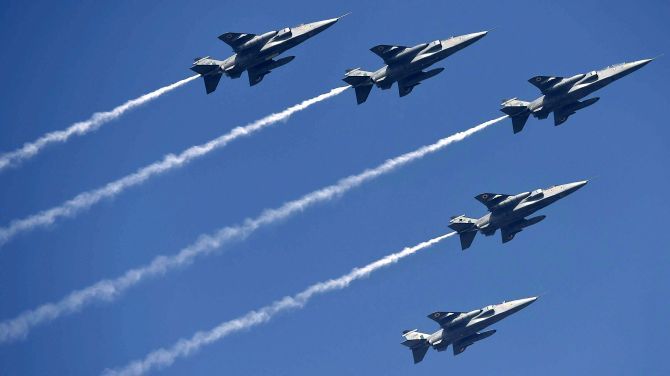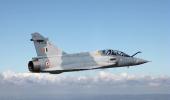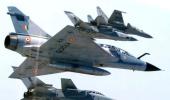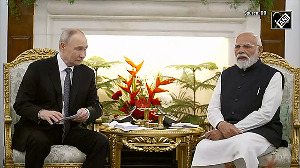'The Balakot mission was an act of political signaling that India is willing to raise the price that the Pakistani State has to pay in order to support terrorism.'

Through the 1990s, the Indian Air Force proposed its capability to strike terror camps in Pakistan occupied Kashmir, but governments did not agree, Air Vice Marshal Arjun Subramaniam (retd) wrote recently.
In the Kargil conflict, the IAF wanted to hit logistics lines across the Line of Control that would choke Pakistani supplies, but was held back with restrictions to not cross the LoC, the retired pilot-scholar elaborated in an The Indian Express op-ed column.
"Up till now India was hesitant to use air power in situations other than full fledged conflict. But now we are willing to use it in order to blend with the environments of contemporary warfare. It is a tool of Statecraft," the former fighter pilot -- who has a PhD in defence studies -- tells Rediff.com's Archana Masih.
The author of three books, Air Vice Marshal Subramaniam is a visiting professor at Ashoka University and the Jindal School of International Affairs. He was formerly a visiting professor at the Fletcher School of Diplomacy and a visiting fellow at Harvard, Oxford and Northeastern Universities.
Part II of the interview with the military historian and commentator.
Part I: 'Abhinandan is a typically aggressive fighter pilot'
What has the Balakot mission achieved for India?
The Balakot mission was an act of political signaling that India is willing to raise the price that the Pakistani State has to pay in order to support terrorism.
To also say that we have the force, the professional competence and the will to go deep inside and strike at targets that we feel support cross border terrorism.
That was the larger message -- and that has been sent.
The second and more important point is that till now India was hesitant to use air power in situations other than full fledged conflict.
But now we are willing to use it in order to blend with the environments of contemporary warfare.
It is a tool of Statecraft.
Why did the IAF not disclose the Balakot battle damage assessment immediately? One retired air force pilot wrote that it was a 'blunder perception battle wise'?
The Balakot strike was a strategic move. The release of photographs and battle damage assessment would be a strategic choice.
I want to ask a counter question why was the whole area cordoned off by the Pakistanis? Why did they not show the Jaish operatives there if nothing had happened to them? It is in the gray zone and we still need to wait.
The official release of photographs, I think, will be done in due course of time.
One takeaway is that while it is important to ask for answers, but in a situation answers may not be forthcoming and with good reason.
It is better to have your action eliciting response from the other side rather than tom-tomming about what you have done.
India has always been a restrained and responsible power. It is not given to beating the drum unnecessarily.
I am not sure there will be a press conference tom-tomming all this. They would just probably wait for the information to come from the other side.
How have these two days in February changed the security situation in India -- when at the same time there has been heavy shelling at LoC? Has it led to further escalation?
Even in the past there have been weeks of very heavy shelling and firing across the LoC. I would argue that these two days have demonstrated a concept that I have been talking about -- the concept to escalate to de-escalate.
There was a message and there was a response. Balakot was the message, the Pakistani air strikes were the response, at least in that escalatory ladder things have quietened down.
Abhinandan has been returned. I am sure there must be an element of sadness that Pakistan lost an F-16 pilot.
That also would have been a sobering factor. The duels on the ground will continue till it de-escalates. I would wait to see what the firing across the LoC will lead to, but I would argue that the worse phase is over.
What happens next?
I don't think both countries will risk using the air force. We can expect a lot of action to shift to the ground.
When the ground action gets a little hot, I think there will be another round of international posturing.
The international community may ask Pakistan to take visible steps against Jaish-e-Mohammad.
In today's time, is there room for a conventional three dimensional war?
There is no room for a conventional three dimensional war as we know it.
Having said that, there is immense space amongst stressed frontiers with both our western and northern neighbour for short, limited and high intensity conflicts, skirmishes and encounters that can be limited in both time and space, with a significant element of surprise.
This includes the maritime dimension, but to anticipate and expect a war like 1971 or the classic Arab-Israeli war or the military engagement during Desert Storm are highly unlikely.
As a military historian, what is the difference in the air wars of today compared to those of the past?
There is a world of difference. Today's air war is about precision and effect.
It is not so much about dropping bombs on a target, it is the effect that that bomb creates.
A small tactical air action to take out a terrorist leader could be carried out by one drone or one aircraft, but the effect of taking out a top terrorist leader is huge.
Air power has this ability of delivering strategic effect even through small tactical actions, whereas in the past you had air forces bashing each other for a week or 10 days -- typical conventional war fighting.
Today it is about effect and precision.
What are the areas that the Indian Air Force needs to concentrate on?
We need the top end 20% of the fleet -- the Rafales and the 110 fighters -- to come in quickly. That is incrementally towards the IAF's authorised strength.
A speedy refurbishment of our fighter platforms to include some cutting edge platforms.
Accelerated delivery of the LCA (Light Combat Aircraft).
Weapon systems to match the profile of the aircraft -- more precision weapons.
But there are fronts where we are comfortable -- like the airlift platform.
The IAF's attack helicopter fleet is going to get significant punch with the Apaches coming in.
The other area that demonstrates that the IAF is right up there with the best air forces is how it supports special forces operations.
What about air defence capability?
The next step forward is the data links that the US and Western air forces have called Link 16.
The next step for the IAF is to move onto the realm of data link, we are doing it but it needs to be accelerated.










